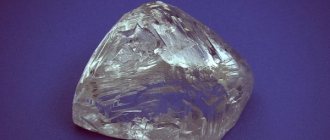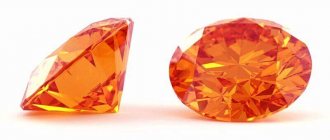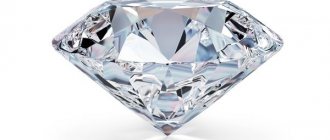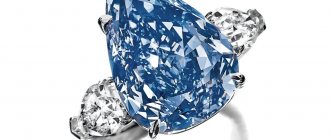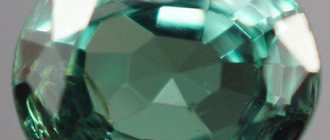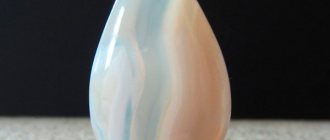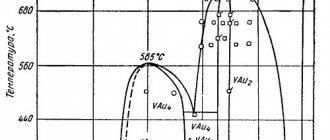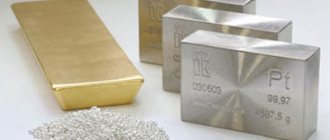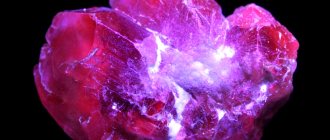| Category | Precious minerals of organic origin |
| Title in English | Coral |
| Formula | CaCO3 |
| Group | Coral group |
| Color | Red, Pink, Orange, Brown, White, Black |
| Stroke color | To be confirmed |
| Shine | Waxy, Dull, Matte |
| Transparency | To be confirmed |
| singonia | Amorphous |
| Hardness | 3 — 6 |
| Cleavage | Absent |
| Density, g/cm³ | 1,3 — 2,7 |
| Kink | Wrong, splintered |
| origin of name | According to the main version, the term “coral” goes back to the ancient Greek word κοράλιον, which translates as “hardened calcareous skeleton of coral animals.” However, it is worth clarifying that the ancient Greeks also borrowed this word from the ancient Romans, who spoke Latin - corallium. |
Corals are the components of the skeletons of coral polyp colonies. Their large accumulations form reefs and even islands. Under the best conditions, corals do not grow more than 1 cm per year, which is why reef formation occurs over hundreds and thousands of years.
Coral deposits
Corals live in seas with a water temperature of at least 21°C, where they form their “bushes” at depths of 3 to 5 m.
After harvesting, coral branches are cleared of soft parts and sorted by quality, branch thickness, color and defects. — Advertising —
Today, corals are most actively mined in the Mediterranean Sea, near the coasts of Algeria, Tunisia, and Italy. On the rocky bottom under the rocks there grow reefs with branches facing down. Corals from Algeria are considered the most valuable, due to the fact that they produce the least amount of waste during processing. Expensive black Akbar corals grow along the coast of India, in the Red Sea basin, next to the Malaysian archipelago. Not far from Africa and the Samoan Islands, red, purple and blue Akori corals are found. Japan is known for its dark red "Moro" corals and pale pink "Bokeh" corals.
What is coral? Properties, extraction, application and price of coral
27,000,000 square meters. This is the area of coral reefs on the planet. Many people want to pinch off a piece of them. If during life a coral is a coelenterate creature, then after death it is a valuable stone.
Living tissues decompose. This is the mouth between the tentacles, the pharynx and the digestive cavity. A skeleton remains. Let's consider what it consists of, what properties it has and where it is used.
What is coral?
Coral is a stone whose composition is either carbonated lime or gorgonine. The latter is similar to the horns of ungulates. The appearance of lime is familiar to many. The total mass of the skeleton is formed from miniature “needles”. They are created by scleroblasts. These are cells specialized in making skeletal parts.
The photo shows red coral
The world of corals began in the Neolithic era. This is the late period of the Stone Age. Corals themselves have also long been considered stones. Later, they began to call them plants. The understanding that we are talking about animals came in the 18th century.
A scientific breakthrough was made by Andrea Peyssonnel. In one of his works, a physician from France wrote that corals are not stone flowers at all, but insects. Externally, Peyssonnel compared coelenterates to jellyfish.
Andrea was laughed at. But when biologists Philippe Cavolini, Vitaliano Donati and Lozano Spaooanzani began to confirm the doctor’s words, corals were recognized as animals.
Corals were classified as polyps already in the 20th century. Biologists call the simplest invertebrates polyps. Single, miniature corals even manage without an external skeleton. Most polyps are stinging.
The photo shows white coral
This means that corals have spiral-shaped threads, prescribed with an immobilizing composition. When straightened, the threads “shoot” at the victims, paralyzing them and dragging them into the polyp’s throat.
Properties of coral
The properties of corals depend on the species and habitat. Thus, the density of some stones is 1.3 grams per cubic centimeter. The indicator for other corals reaches almost 3 grams for the same area.
In the first case, we are talking about maximally porous stones, reminiscent of pumice for heels. In the latter case, low-porosity corals are described. Third-party impurities, for example, metals captured during the growth process, can make them heavier and denser.
Corals are also saturated with third-party organisms. As a rule, these are unicellular zooxanthellae. They are a type of algae that form a symbiosis with the hero of the article, that is, mutually beneficial coexistence.
The photo shows beads made of purple coral
Corals serve as their home, and the polyps feed on the products of photosynthesis carried out by zooxanthellae. Since they need light to function, there are almost no algae in the skeletons of deep coelenterate algae.
Their color depends on the presence of algae, the composition of the water and the depth of habitat of the polyps . coral is usually lighter than coastal coral. Although, if there is a lot of manganese in the water, the stone will capture it and turn deep purple, purple even in the Mariana Trench.
In total, scientists count about 350 color varieties of corals. Photos of blue polyps were brought from the African shores. Red coral was recorded near Japan. However, we will talk about the dislocation of an organic mineral in a separate chapter. In the meantime, let's continue the list of physical properties of corals.
Natural coral is varied not only in density and color, but also in hardness. One point run up. Some polyps have a hardness of only 3 points, like calcite. Other corals are given a 4 on the Mohs scale. Fluorite has the same amount. It is calcium fluoride, known as fluorspar because it melts easily.
Coral is also unstable to temperature influences. The stone begins to lose color and crumble. This also happens in an acidic environment. The lime from which the polyp skeleton is built is calcium carbonate with the formula CaCO3.
In the photo there is a bracelet made of black coral
Mineral impurities can amount to several percent. Organics are usually about 1%. More only in black corals found off the coast of India. Due to the abundance of organic matter, polyps, by the way, turn black. So, calcium carbonate reacts violently with acid, releasing carbon dioxide.
Coral mining and deposits
Coral is classified as a biogenic precious stone. From a scientific point of view, the mineral is more likely bone. Its formation, like that of humans, depends on the quality of nutrition and the receipt of solar vitamin D.
Therefore, polyps are picky about the purity of water. By polluting the ocean, humans are reducing the habitats of coelenterates. Sea corals are becoming rare. They did not even think of living in rivers and lakes. Therefore, the price of stones is rising.
Untreated red coral
For now, reefs are preserved off the islands of the Hawaiian archipelago and Japan. Both there and there red corals . However, the best samples are brought from Spanish Sardinia. The best is determined by the color saturation, porosity of the polyp and its shape. Branched corals are the most in demand.
Black coral is mined not only near India, but also in Hawaii, as well as in the seas of Mexico. Polyps, dark as night, are, by the way, the most expensive in the world. The least valued is white coral . It, along with red, is mined in the waters of Japan and the Pacific Ocean in general. The white polyps are called "Bianco". They are the most budget friendly.
Among the corals there is also “Gold”. This is the name given to a type of polyp from the Hawaiian Islands. Polyps are, in principle, most diverse and widespread within the Caribbean Sea. The name of the species is given due to its golden brown color. There is no precious metal in corals.
Blue corals are the hardest to get. Their name is “Heliopor”. Blue polyps grow at depth. There, the color of the lime frames is close to indigo. However, in the sun the paint fades and white spots appear.
In the photo there are earrings made of red coral
Therefore, prospectors rarely waste energy on dangerous expeditions to thousand-meter depths. It is more profitable to go to coastal areas for “Angel Skin”. These are flesh toned stones. They have a pearlescent sheen that adds charm and value. High-quality samples of “Angel Skin” can cost on par with black corals.
Applications of corals
Russians are accustomed to seeing earrings with corals , rings, and pendants. But in the regions where polyps live, they are also perceived as a building material. For example, there is a castle made of coral blocks in Florida.
The word “castle” refers to a complex of buildings and statues. Author's composition. Architect Edward Lidskalnins personally carried limestone blocks from the coast for 20 years, cut them and put them together.
No joining solution was used. Although, in other coral buildings, a lime solution is used. It is obtained by crushing and diluting the same polyps with water.
Calcium carbonate, that is, lime, in some corals is 90-97%. The skeletons of madrepore polyps are famous for their maximum level. Lime made from them is a snow-white powder of the highest quality.
Only ancient corals are suitable for it, as well as building blocks. Recently deceased are no good. The skeletons of such coelenterates are excessively porous. This makes corals susceptible to external influences, particularly moisture. Rainfall destroys young polyps, and in the regions where they are found, precipitation is not uncommon.
Non-noble polyps are used in construction. Only jewelry types are inserted into coral jewelry There are 16 of them. Agatized coral stands to the side. This is a fossil species.
The living tissues in it died so long ago that the external skeleton managed to be partially replaced by agate over the millennia. This mineral is a silicon oxide and is famous for its banded, iridescent coloration.
The tones of agate are mainly brownish, yellow, and orange. Therefore, autumn leaves are cut out from mineralized polyps. To imitate tree branches, you don’t need to grind anything. Roses are made from corals if the stones are red or peach. The buds made of black lime look mystical.
Coral price
For the collection , corals can be purchased in the form of branches and individual polyps. For a 5-centimeter pink branch they will ask about 600 rubles in the case of a simple shape. Bushy branches of the same length cost 1,300 rubles.
Determining the price of coral in jewelry is difficult. The cost largely depends on the metal used, its quantity, design refinements and the fame of the master’s name. In addition, you need to consider whether the stone is real.
In the photo there are beads and a bracelet made of purple coral
Sometimes colored plastic is passed off as coral. Under a magnifying glass it is homogeneous, and the texture of the polyps resembles wood. Another authenticity test involves a vinegar solution. We need a weak one. The coral, dipped into the solution, bubbles.
This releases carbon dioxide. Remember the reaction with acids? In general, there are a lot of technical questions. Perhaps that is why the name of the hero of the article was used in its title by one of the computer equipment stores. Coral Micro offers popular electronics. It can be a home decoration, but it is not a substitute for true coral jewelry.
History of coral
The name "coral" has German and Polish roots, which in turn go back to ancient Greek origins.
They have been known to man for quite a long time. In Ancient Greece, pink corals were considered a source of immortality and happiness. And in Europe in the Middle Ages, corals symbolized modesty and purity. It was believed that they add wisdom and intelligence, develop logic and intuition, and enhance memory. Talismans with corals were used to protect against various troubles, in difficult situations, and also to protect oneself from evil forces.
Today, corals remain popular in jewelry and decorative items. Corals are found both in tropical seas and oceans and in the cold Atlantic Ocean. To date, scientists have described such varieties of corals as fan-shaped and tree-shaped, as well as subspecies of different color characteristics.
Origin story
The name of the stone has several versions. According to one of them, the Greek word “coralion” means “that which was hard in the hand.” Coral was popular back in Mesopotamia and Ancient Egypt, but it earned special respect during antiquity.
It often figured in ancient Greek mythology, and the supreme sea god Poseidon lived in a palace built from these stones.
According to another version, the Arabic word “goral” means “amulet stone”. Muslims used black corals to create mourning wreaths, rosaries, knife handles, and cane handles. It was believed that the powerful spiritual powers of the stone were transferred to its owner.
In Rus' there was a widespread belief that coral was found in the brain of a dragon, so it was called dragonite. It was considered a prophetic stone and was used to perform magical rituals. Ominous properties were attributed to draconite; he was an instrument of revenge and damage.
In the Middle Ages, Venice became the center of trade in these stones. Red corals were used to make body jewelry, miniature sculptures, and inlaid weapons and church book covers with them. The pink stone was worn by young girls as a symbol of modesty and purity.
These days, most corals come to the world market from India, Japan, Hong Kong and Taiwan. The unusual stone is still of interest not only to collectors, but is also experiencing a new wave of popularity.
Physicochemical characteristics of coral
Coral is made up of hard minerals such as aragonite and calcite. Its chemical composition is represented by calcium and magnesium carbonates, as well as iron oxides. Typically, corals contain approximately 1% organic matter. Only in Indian black corals do organic components predominate.
The hardness of corals on the Mohs scale is 3.5-4. Specific gravity 2.6-2.7 g/cm3. Untreated corals have a matte surface, with spots, cracks and pores. When polished, a glassy shine appears. The smoother the color and the fewer defects natural coral has, the more valuable it is. A characteristic property of corals is their susceptibility to high temperatures and acids.
Physicochemical characteristics
Coral is an opaque stone that is translucent around the edges. The hardness of the mineral is low: for red varieties it is 3-4 according to Mohs, for black varieties it is two times lower. As a result, the coral is easily scratched by a knife.
In its raw form, the stone has a matte, even rough surface. It is rubbed with special wax polishes, giving it a silky shine.
When worn, natural corals may fade and turn pale. But the most common reason for this phenomenon is poor-quality painting.
Cheap white and even pink corals are dipped in hydrogen peroxide to impart the popular red hue, and are also treated with chemical dyes.
The magical properties of coral
Coral amulets attract good luck to their owner, endow him with the gift of foresight, and have a good effect on mental state and logical thinking.
They are believed to protect against the evil eye and lightning. In addition, corals are an excellent remedy for fatigue and for increasing vitality. They relieve tension, apprehensions, fears, depression, and give prudence. The positive effect of coral on the psyche is reflected in the neutralization of such negative states as anger and envy.
Coral amulets are considered the best protectors against bad people, and they are often given to children. Coral also protects travelers from hurricanes and storms, and helps them return home safely.
Magical properties and beliefs
As a talisman, coral improves memory. It is considered a talisman against poison, witchcraft, shortness of breath, loss of appetite, and develops intuition and logic.
The ideal time to wear it is the new moon phase, and the most dangerous time is the full moon period. It is not recommended to wear coral jewelry often, as it provokes capriciousness and eccentricity.
Natural stone has long been considered the patron saint of travelers.
It protects against dangers that lurk on long journeys, helps to establish new connections, calms bad weather, calms storms and thunderstorms.
However, a coral sunset in the evening sky foreshadows windy and turbulent weather.
Phallic-shaped coral amulets are very popular in Thailand.
They symbolize the linga of the god Shiva, which protects the owner from evil spirits. Amulets are worn around the neck or on the belt, mantras are read over them, and ritual chants are performed.
In South India, Kyrgyzstan and Tajikistan, women wear coral beads to bring peace and harmony to their marriages and to cope with infertility.
In addition, the mineral acts as an indicator of health status - a sharp loss of color indicates a serious illness of its owner. If you dreamed of coral, this is a sign of recovery from a serious illness.
35 years of married life together is called a coral wedding. On this anniversary, husband and wife give each other jewelry with coral inserts, talismans and souvenirs.
The healing properties of coral
The healing qualities of coral are associated with its composition, which is represented by a large amount of calcium and many important trace elements, such as iodine.
Coral powder has long been used in folk medicine to restore the skeletal system and treat thyroid diseases.
Preparations based on corals increase tone, improve memory, and support the cardiovascular and nervous systems. With their help, diseases of the liver, intestines, and stomach ulcers are treated. In addition, they relieve headaches, gout attacks and sore throats.
Branches of application of coral
The coral “tree” basically contains a stump with branches.
Not all of them are suitable for jewelry making, as they can be thin and dense. The processing of suitable parts of coral is done in an oval, ball or cabochon. In the past, talismans and amulets made from coral were very popular. Later, beads, rings, earrings, necklaces, tiaras and other products based on them came into fashion. At the same time, red corals were considered the most popular. In countries such as Ukraine and Poland, coral beads were a mandatory attribute of women's costumes, by which one could judge the financial situation of the family.
The hard skeletons of corals are used as raw materials for the production of lime. In jewelry today, black, white and silver-pearl corals are considered the most valuable, although red and pink still remain popular colors for them. In addition, corals are used in medicine and cosmetology.
Decorations
The most traditional coral jewelry is beads. They help give the image bright and rich folk notes. But the richness of the natural palette allows the mineral to be used in a wide variety of jewelry.
A soft pink coral is suitable for a young girl’s ring, a bright orange set in gold will decorate a mature lady, a rich black one will elevate a man’s signet or bracelet.
Unprocessed coral branches are also used as decorations. They are called cornetti and are worn around the neck in the form of a pendant. This unusual product goes well with a romantic look.
Coral colors
There are more than 6,000 species of corals, the color palette of which includes about 350 shades. The color of coral is affected by the composition and amount of organic compounds, which can range from 1% to almost 100%. The most famous are pink, red, blue, white and black corals. It is the latter that contain the most organic substances, are highly valued and are even included in the Red Book, and their industrial extraction is prohibited. The rarest are blue corals.
Artificial coral
The technique for producing artificial corals of different colors was developed in France by scientist P. Gilson.
For this, dye and natural calcite are used, which are exposed to high temperatures and pressure. These synthetic corals, unlike natural ones, do not have a mesh pattern or organic compounds in their composition. Artificial or pressed coral is much cheaper than natural coral, although it is very similar in physical properties.
How to distinguish real coral from a fake
The simplest option for imitation coral is plastic products in red or orange shades.
When you touch them with a hot needle, a black dot and the smell of burnt plastic appear, which distinguishes them from natural corals. Synthetic pressed coral, tinted in various colors, is distinguished by its lighter weight and the effervescence of the sample when it reacts with hydrochloric acid.
Dye-dyed white corals leave traces of dye in the water when immersed in hot water. In hot weather, they can even stain the skin.
In addition, fake coral is made from rose quartzite. They differ to the touch: quartzite is a cold stone, while coral resembles amber. When cut, quartzite has a grayish, stony texture, while coral has a shiny texture.
How to spot a fake?
Gilson coral
The main criterion by which you can determine whether the coral you are looking at is natural is its price. It shouldn't be too low.
Currently, several substitutes for natural stone are common:
- Synthetic analogue, or Gilson coral. It was first obtained in 1972 in a Swiss laboratory from calcite powder. In terms of its physical and chemical properties, Gilson coral is almost identical to stone mined from the ocean depths, but is much cheaper. It can be distinguished from a natural mineral by the absence of a characteristic mesh pattern on the surface.
- Quartzite. This is a cheap stone that looks like coral. It is easy to recognize by its temperature - it always remains cold.
Quartzite
- Imitation coral. They are created from pressed coral shavings with the addition of dyes and plastics. There are also very cheap counterfeits, consisting entirely of glass, plastic or polymers. They are easy to recognize by their uniform color, which is very rare in nature. You can grind a piece of stone and add acetic acid - the natural calcium material will enter into a chemical reaction, causing bubbles to form on the surface.
Like many seafood, natural coral becomes brighter after being in water for a long time: this does not happen with imitations and fakes. On the contrary, if a low-quality colored stone was purchased, the water may change color.
Interesting facts about coral
- It is prohibited to export corals from Egypt and Thailand, and attempts to violate this ban are punishable by a fine of $1,000.
- Corals are unique in that they have growth rings, like trees. These rings are used to determine the age of corals, which reaches hundreds of years.
- Classic corals grow in tropical waters, and their hardness allows them to withstand the harsh conditions of rough seas and oceans. Corals with a thin plate structure are found only at great depths in lagoons.
- Large, hard coral beds act as cleaning stations in the seas for fish and animals, which rub against them to remove layers of dead skin or parasites.
- In shallow waters, corals are damaged by ultraviolet radiation. If the ozone layer decreases significantly, corals in shallow waters will not be able to grow.
